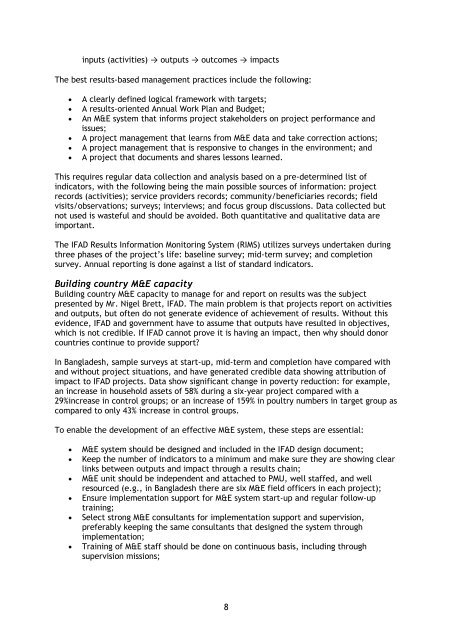Workshop Report pdf - IFAD
Workshop Report pdf - IFAD
Workshop Report pdf - IFAD
You also want an ePaper? Increase the reach of your titles
YUMPU automatically turns print PDFs into web optimized ePapers that Google loves.
inputs (activities) → outputs → outcomes → impacts<br />
The best results-based management practices include the following:<br />
• A clearly defined logical framework with targets;<br />
• A results-oriented Annual Work Plan and Budget;<br />
• An M&E system that informs project stakeholders on project performance and<br />
issues;<br />
• A project management that learns from M&E data and take correction actions;<br />
• A project management that is responsive to changes in the environment; and<br />
• A project that documents and shares lessons learned.<br />
This requires regular data collection and analysis based on a pre-determined list of<br />
indicators, with the following being the main possible sources of information: project<br />
records (activities); service providers records; community/beneficiaries records; field<br />
visits/observations; surveys; interviews; and focus group discussions. Data collected but<br />
not used is wasteful and should be avoided. Both quantitative and qualitative data are<br />
important.<br />
The <strong>IFAD</strong> Results Information Monitoring System (RIMS) utilizes surveys undertaken during<br />
three phases of the project’s life: baseline survey; mid-term survey; and completion<br />
survey. Annual reporting is done against a list of standard indicators.<br />
Building country M&E capacity<br />
Building country M&E capacity to manage for and report on results was the subject<br />
presented by Mr. Nigel Brett, <strong>IFAD</strong>. The main problem is that projects report on activities<br />
and outputs, but often do not generate evidence of achievement of results. Without this<br />
evidence, <strong>IFAD</strong> and government have to assume that outputs have resulted in objectives,<br />
which is not credible. If <strong>IFAD</strong> cannot prove it is having an impact, then why should donor<br />
countries continue to provide support?<br />
In Bangladesh, sample surveys at start-up, mid-term and completion have compared with<br />
and without project situations, and have generated credible data showing attribution of<br />
impact to <strong>IFAD</strong> projects. Data show significant change in poverty reduction: for example,<br />
an increase in household assets of 58% during a six-year project compared with a<br />
29%increase in control groups; or an increase of 159% in poultry numbers in target group as<br />
compared to only 43% increase in control groups.<br />
To enable the development of an effective M&E system, these steps are essential:<br />
• M&E system should be designed and included in the <strong>IFAD</strong> design document;<br />
• Keep the number of indicators to a minimum and make sure they are showing clear<br />
links between outputs and impact through a results chain;<br />
• M&E unit should be independent and attached to PMU, well staffed, and well<br />
resourced (e.g., in Bangladesh there are six M&E field officers in each project);<br />
• Ensure implementation support for M&E system start-up and regular follow-up<br />
training;<br />
• Select strong M&E consultants for implementation support and supervision,<br />
preferably keeping the same consultants that designed the system through<br />
implementation;<br />
• Training of M&E staff should be done on continuous basis, including through<br />
supervision missions;<br />
8
















